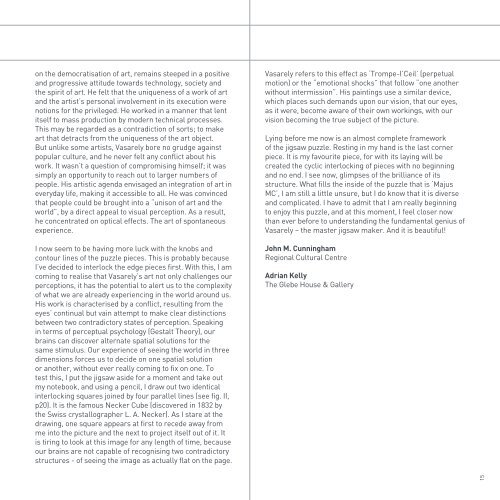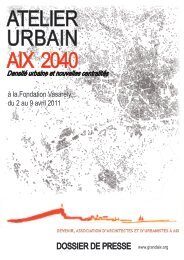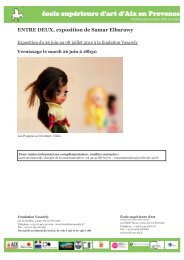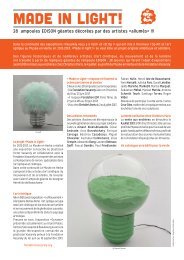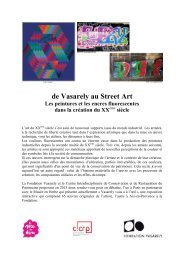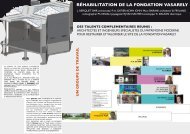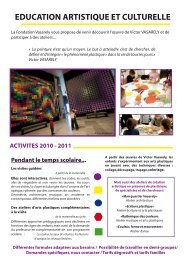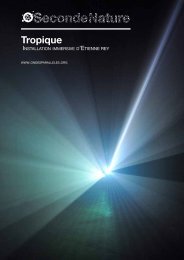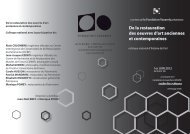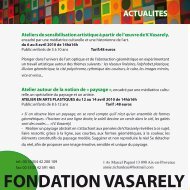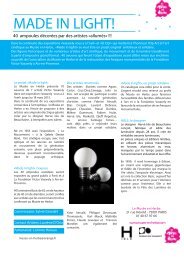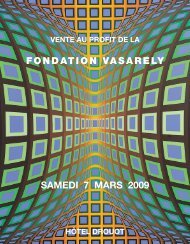Victor Vasarely - Fondation Vasarely
Victor Vasarely - Fondation Vasarely
Victor Vasarely - Fondation Vasarely
Create successful ePaper yourself
Turn your PDF publications into a flip-book with our unique Google optimized e-Paper software.
on the democratisation of art, remains steeped in a positive<br />
and progressive attitude towards technology, society and<br />
the spirit of art. He felt that the uniqueness of a work of art<br />
and the artist’s personal involvement in its execution were<br />
notions for the privileged. He worked in a manner that lent<br />
itself to mass production by modern technical processes.<br />
This may be regarded as a contradiction of sorts; to make<br />
art that detracts from the uniqueness of the art object.<br />
But unlike some artists, <strong>Vasarely</strong> bore no grudge against<br />
popular culture, and he never felt any conflict about his<br />
work. It wasn’t a question of compromising himself; it was<br />
simply an opportunity to reach out to larger numbers of<br />
people. His artistic agenda envisaged an integration of art in<br />
everyday life, making it accessible to all. He was convinced<br />
that people could be brought into a “unison of art and the<br />
world”, by a direct appeal to visual perception. As a result,<br />
he concentrated on optical effects. The art of spontaneous<br />
experience.<br />
I now seem to be having more luck with the knobs and<br />
contour lines of the puzzle pieces. This is probably because<br />
I’ve decided to interlock the edge pieces first. With this, I am<br />
coming to realise that <strong>Vasarely</strong>’s art not only challenges our<br />
perceptions, it has the potential to alert us to the complexity<br />
of what we are already experiencing in the world around us.<br />
His work is characterised by a conflict, resulting from the<br />
eyes’ continual but vain attempt to make clear distinctions<br />
between two contradictory states of perception. Speaking<br />
in terms of perceptual psychology (Gestalt Theory), our<br />
brains can discover alternate spatial solutions for the<br />
same stimulus. Our experience of seeing the world in three<br />
dimensions forces us to decide on one spatial solution<br />
or another, without ever really coming to fix on one. To<br />
test this, I put the jigsaw aside for a moment and take out<br />
my notebook, and using a pencil, I draw out two identical<br />
interlocking squares joined by four parallel lines (see fig. II,<br />
p20). It is the famous Necker Cube (discovered in 1832 by<br />
the Swiss crystallographer L. A. Necker). As I stare at the<br />
drawing, one square appears at first to recede away from<br />
me into the picture and the next to project itself out of it. It<br />
is tiring to look at this image for any length of time, because<br />
our brains are not capable of recognising two contradictory<br />
structures - of seeing the image as actually flat on the page.<br />
<strong>Vasarely</strong> refers to this effect as ‘Trompe-I’Ceil’ (perpetual<br />
motion) or the “emotional shocks” that follow “one another<br />
without intermission”. His paintings use a similar device,<br />
which places such demands upon our vision, that our eyes,<br />
as it were, become aware of their own workings, with our<br />
vision becoming the true subject of the picture.<br />
Lying before me now is an almost complete framework<br />
of the jigsaw puzzle. Resting in my hand is the last corner<br />
piece. It is my favourite piece, for with its laying will be<br />
created the cyclic interlocking of pieces with no beginning<br />
and no end. I see now, glimpses of the brilliance of its<br />
structure. What fills the inside of the puzzle that is ‘Majus<br />
MC’, I am still a little unsure, but I do know that it is diverse<br />
and complicated. I have to admit that I am really beginning<br />
to enjoy this puzzle, and at this moment, I feel closer now<br />
than ever before to understanding the fundamental genius of<br />
<strong>Vasarely</strong> – the master jigsaw maker. And it is beautiful!<br />
John M. Cunningham<br />
Regional Cultural Centre<br />
Adrian Kelly<br />
The Glebe House & Gallery<br />
15


